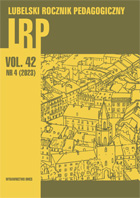KONSTRUKCJA I WALIDACJA SKALI DO BADANIA
CYBERPRZEMOCY (SDBC)
CONSTRUCTION AND VALIDATION OF THE SCALE FOR THE STUDY OF
CYBERBULLYING (SSC)
Author(s): Zdzisław Bartkowicz, Andrzej Chudnicki, Natalia CzopekSubject(s): Media studies, Studies in violence and power
Published by: Wydawnictwo Naukowe Uniwersytetu Marii Curie-Sklodowskiej
Keywords: cyberbullying; cybervictimisation; adolescents; measurement scale; psychometric properties;
Summary/Abstract: Introduction: Cyberbullying is becoming an increasingly serious problem among children andadolescents, threatening safety and mental health, and posing new tasks for psychological andpedagogical support. Diagnosing the dangers of engaging in cyberbullying is a task that re-quires appropriate tools to assess in detail the ways, in which others are attacked virtually andthe individual’s participation as a perpetrator or victim of cyberbullying. It is felt that there isa lack of appropriate tools that measure cyberbullying multifacetedly, as a way of behaving inthe virtual world, that is perceived by the individual in terms of good and bad.Research Aim: This article presents the conceptual assumptions and stages in the construc-tion of a new tool to measure cyberbullying. The Cyberbullying Screening Scale consists of 4subscales measuring the frequency of manifesting and experiencing 17 modes of virtual harm.In addition, respondents rated how often individual acts of cyberbullying occur in the schoolenvironment and to what extent they are bad or meaningless.Method: The analysis of psychometric properties was based on the results of the survey of 240secondary school students.Results: Factor analysis established a set of items for the individual subscales. High reliabilityindices were obtained for all subscales. A preliminary standardisation of the tool was carriedout, as a result of which it was determined how many perpetrators, victims and aggressive vic-tims of cyberbullying are in the study group.Conclusion: The results obtained are consistent with those obtained in different countries us-ing other tools.
Journal: Lubelski Rocznik Pedagogiczny
- Issue Year: 42/2023
- Issue No: 4
- Page Range: 163-181
- Page Count: 19
- Language: Polish

